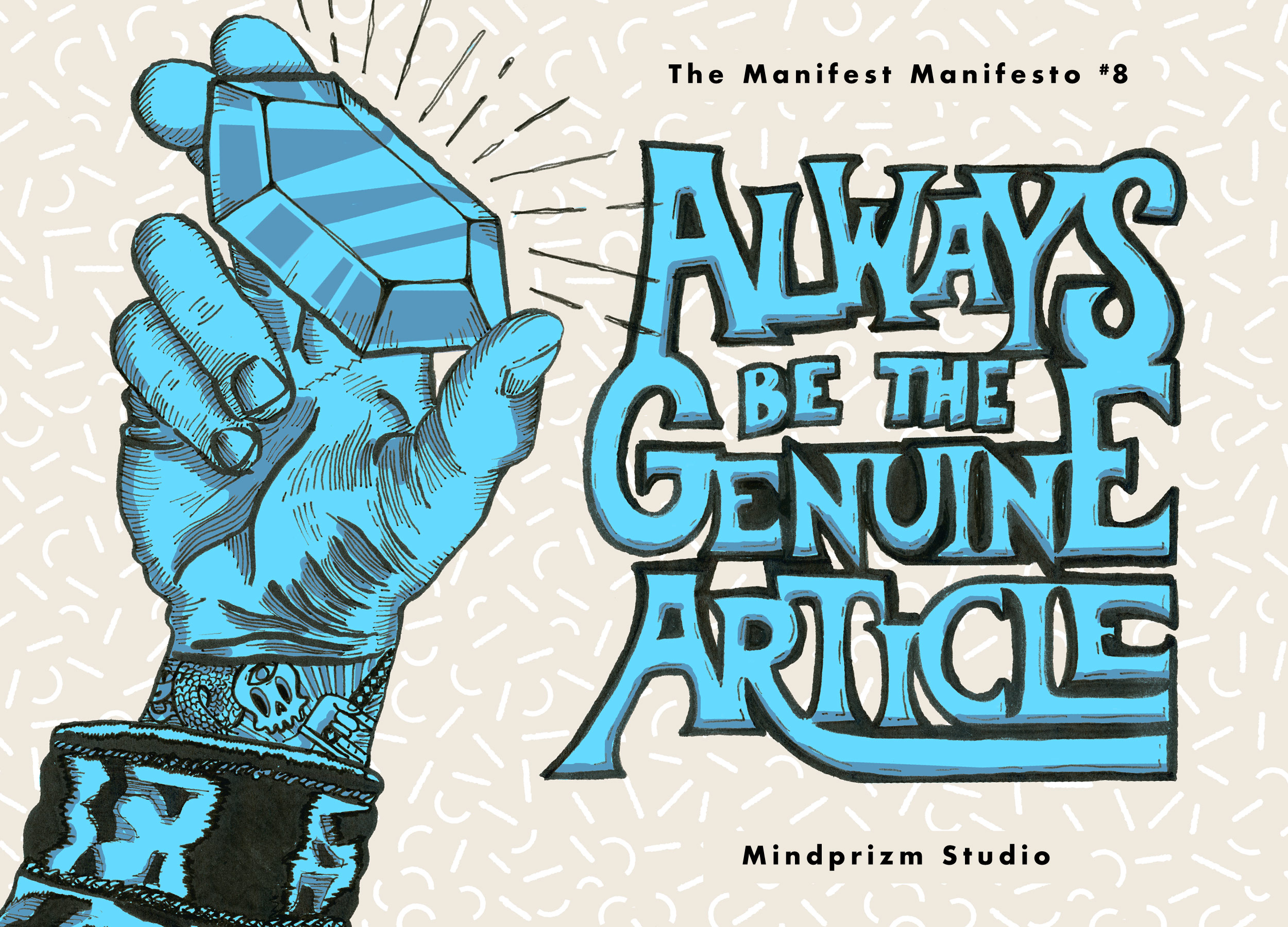The Manifest Manifesto #8: Always Be the Genuine Article
Putting this into practice isn't always easy or convenient (especially when getting hired for a job is potentially on the line), but it will save you from a world of headache and heartache.
When I was concepting the Anchor® Appetizers campaign launch video (what would eventually look like this ) I knew I wanted to do something remarkably out of the ordinary. After all the brand promise is "Always Original" and I felt that whatever we came up with needed to be emblematic of that. Anchor made a name for themselves by inventing the jalapeño popper and other similarly interesting appetizers, but had been quiet in the marketplace for a couple years both from a communication and innovation standpoint. This video was to be a roaring first glimpse at a recommitment to their expertise by turning the tables on expectations, even as they helped foodservice operators actually "turn tables" with quality innovative products. In my mind, all of this could be shown through a gravity-defying table that flipped ever-forward; an idea that had been baking in my head for about 5 years.
Obviously, a hydraulic table wasn't going to work because the food would fly everywhere. Similarly, I wasn't interested in either building everything in 3d or using a parlor trick in post. Doing so wouldn't have been honest and my suspicion was that the cracks in the execution would be evident. I wanted something that would keep the actual food the focal point, but also have the viewer asking "Okay, how'd they do it?"
All of this builds into that 85% certainty. Strategically the idea made sense, particularly after my copywriting partner shaped the narrative. Creatively, it would deliver on the brand promise in an unexpected way. Practically, I still needed to do some homework to ensure I totally held up my end of the bargain.
This doesn't mean that after you've pitched a concept that your vision will change marginally based on actual budget (or lack thereof) and client input. What this does mean is that you shouldn't sell snake oil. You as the future proud parent of an idea being birthed into the world, need to ensure that you can actually support this child. For me this meant that I became obsessed with figuring out how to turn that bloody table and until I did I wouldn't pitch this idea, no matter how much I believed in it.
The answer was actually rather simple in principle: Move the camera, not the table. This would allow an entire world of movement to exist on and off the table itself. Sure lighting would be tricky along with holding a focal point on the food itself as the camera gracefully arced over everything, but in theory this would work. So I drew up a simple diagram and reached out to the super talented folks at Bruton Stroube to see if such a thing could be accomplished. After a few very thorough conversations with them, they looked at the diagram and said "Yes, in a very simple way, this is exactly how you'd do it." (Obviously the final execution would take some master fabrication and a crew of about 10 other people to pull off, but it was possible.)
So, why didn't I just reach out to them in the first place? Because passing the buck isn't really a successful strategy in the preliminary stages of a project, after all it's my reputation that's on the line if things go wrong. To be accountable for both the good and the bad, you must completely understand the thing in order to stay engaged.
Then came the pricetag.
To do this correctly, it would be more expensive than the budget we'd been given.
No problem.
Why? Because this wasn't the only concept the copywriter and I had come up with. We had three others. Every one of them was on strategy, but had varying degrees of difficulty in execution and were priced accordingly. This is an extremely important point. Part of delivering the goods is ensuring there's something in the mix that your audience can buy. It may not be the best or most exciting idea, but this is exactly what they hired you for. It's then up to you to convince them why they should do something that might make them a little uncomfortable.
I was extremely up front in the potential cost of the Turning Tables concept while also explaining that for this particular idea there wouldn't be a way to trim costs. With three other completely buyable concepts out there, I wasn't worried in the slightest.
Surprisingly, they chose to spend a bit more, because the impact would be worth it.
This began several straight weeks of daily phonecalls with the studio leading up to the shoot as they confirmed details and vision for the project (yes, as a matter of fact I am going to be obsessed with how the shadows move). All of this minutia was essential to the success of the video and Bruton Stroube's shared obsession with it is part of what makes them so good at their craft.
The final result I'm still very proud of and also something that wouldn't have been possible if at any point I gave the project less than it deserved because there wasn't enough time, I was overextended, or simply because I was incapable of delivering the skillset necessary. This is exactly what I'd signed up for when I pitched the idea and the client said "yes."
Side note: the digital world in which we live makes it relatively easy to overpromise skills or expertise and then "borrow" others' ideas and executions without taking the time to understand how they actually work and/or put an original spin on them. This is risky and unethical for a number of reasons and whoever hired you deserves better. If you can't deliver, gracefully get out or find someone who can and shepherd the project. You owe it to your client and all your fellow craftspeople out there who can.
So what about that last 15%?
Great question, I'm so glad you asked.
There are few things in this world that require more faith than the creative process. I mean c'mon there's a blank page, or canvas, or screen in front of you and something has to literally come from nothing while trying to beat a clock. Pair that with a healthy dose of subjectivity and a seemingly infinite number of starting points and you've got a powderkeg for choice paralysis. To make things worse, there's a million things that can go wrong after you've begun a project. At least math is usually predictable.
The last 15% is the everything else.
You've made your best guess. You've assembled whatever superteam is necessary (which may just be you). You've steeled your resolve and set out into the wilderness of execution. You're 85% sure it's gonna turn out, but there's a lot of uncertainty in this world, especially if you plan on doing something remarkable and new.
Just. Don't. Quit. Unless there's absolutely no other option. Keep pressing onward until that last 15% is conquered. Don't stop until it is.
After all, you're the genuine article, right?
-M

